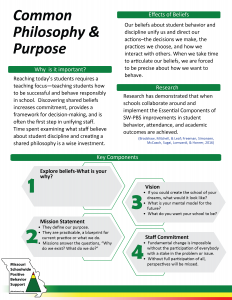Common Philosophy and Purpose
Effective schools commit their philosophy of discipline to writing through their beliefs, mission, and vision. This philosophy creates a sense of direction that gives coherence to diverse activities. It also serves to clarify to others outside of staff how the school operates regarding discipline and protects and helps sustain the work. Time spent examining what staff truly believes about student discipline and creating a shared philosophy is a wise investment in lasting change (Good & Brophy, 2000).
Learner Objectives:
- Explore beliefs about discipline and establish your building’s “why”.
- Review and/or create a mission statement to verify that it addresses the development of student social competence.
- Review and/or create a vision statement to verify that it addresses the development of student social competence. gain and document staff commitment to SW-PBS.
Essential Functions:
- The building leadership team has established a list of common beliefs about students and behavior.
- The building’s mission and vision statements address the development of student social competence.
- The building leadership team has gained and documented staff commitment to SW-PBS.
Participant and Presenter Materials
Recommended Prerequisites
- MO SW-PBS Handbook: Section 1 Overview
- MO SW-PBS Tier 1 Implementation Guide, Course 1: Common Philosophy & Purpose
Participant Materials
Participant Handouts
Pre/Post Learner Assessment
Pre-and post -Knowledge checks are a component of high-quality professional development. It is recommended that all consultants and other trainers/facilitators use them as they tailor their professional development for their audience. The pre/post knowledge check and the answer key are posted below for downloading and administering.
Presenter Materials
Presenter PowerPoints with Notes: A PowerPoint file with detailed presenter notes is available for the module.
Implementation Supports
![]() Scoring Rubric for Common Philosophy and Purpose Update coming soon
Scoring Rubric for Common Philosophy and Purpose Update coming soon
![]() Common Philosophy and Purpose Leadership Team Assessment
Common Philosophy and Purpose Leadership Team Assessment
![]() Common Philosophy & Purpose Coaching Companion
Common Philosophy & Purpose Coaching Companion
- Watch his following TED Talk called “How Great Leaders Inspire Change” https://www.ted.com/talks/simon_sinek_how_great_leaders_inspire_action?utm_campaign=tedspread&utm_medium=referral&utm_source=tedcomshare

